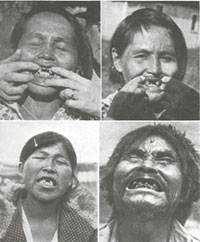How to cut through all the modern day science with a little help from the past.
Pick up any newspaper or health magazine and you’ll find any number of conflicting articles about what is healthy nutrition and what is not. One minute alcohol is bad for your liver and should be avoided, the next minute it extends life. It’s the same with supplements – one day they are just expensive urine that do nothing, the next day they reduce the risk of heart disease. So why is there so much conflicting information and how do you cut through all this to make the best choices?
With most research there is always an ulterior motive built in, pharmaceutical research will tell you that drugs help treat diseases – such as statins lowering LDL cholesterol and preventing heart disease. Of course they will, they are not going to pay for or publish a study that says their drugs don’t work. More alarmingly, these companies have been known to press ahead with pushing drugs on the market that are not properly tested or are in fact harmful – think of some of the drugs that have been taken off the market because they cause deaths – such as the anti-inflammatory Vioxx.
It’s the same for research on food. Take organic food for example, the big corporations will tell you that pesticides are harmless – of course they will. They are not going to publish research that says they are dangerous – they wont sell any pesticides to farmers. Conversely organisations that stand to profit from selling organic food will tell you that organic food is more nutrient dense and healthier. The same is true for vitamin pills, protein powders and all manner of other supplements. Invested interests always win.
There are few well-designed independent research studies out there that are not biases in some way or that do not have an invested interest at heart. When a good piece of research does come out – it is either ignored by the mass media and only really acknowledge by industry professionals who then try to pass this information on to the public. Or worse it is attacked and vilified by the big corporations who stand to lose profits from information that disagrees with their point of view gathering publicity.
Do not get me wrong – reading research is vitally important to keep up to date with the continually evolving evidence base of what actually is healthy and what is not – it’s just that some people will only ever recommend or suggest anything that has research to support it. This is like looking at the world through a straw. First, as I have said a lot of research is biased – it doesn’t mean it should be ignored, you just have to evaluate it and put in to the context that the research was conducted in. You need to ask who funded it, what are the outcomes from this research? What do the people who funded the research stand to gain? Can I rely on it?
Secondly, having a piece of research to support your claims or points of view are not always the gold standard. Clinical experience also has a huge role to play. Take for instance folic acid, it took nearly 40 years of research before doctors accepted that it prevented spina biffida, if it had been a drug it would have been accepted and on the markets within months – not years. How many people could have been saved from spina biffida had people just accepted that folic acid worked and that taking a small dose might have a beneficial effect and probably wouldn’t have any harmful effects? Did we really need to wait 40 years for science to rubber-stamp its use?
So where do we go from here, what do we believe? As I said ignoring all the research that comes out is a mistake, it should be sifted through and used in conjunction with these 2 gems from the past and 1 from the present…
Weston A Price was a dentist and scientist who travelled the world in the late 1920’s and early 1930’s studying indigenous populations food and nutrient intake and looking at their dentition and what diseases they suffered from. He studied Eskimos, North American Indians, South American Indians, African tribes, the Aborigines, New Zealand Maori, Pacific islanders, isolated Swiss and Irish communities and communities in India. Each group studies all ate different diets, foods that were available to them in their natural surroundings and that their families had eaten for generations.
The Eskimos ate a lot of salmon, seal meat, elk and very little fresh fruit and vegetables as it just wasn’t available to them; South American Indians ate rodents and insects and plant life, large game wasn’t available to them; the African tribes lived off of cows blood and dairy, the Aborigines lived off of grubs and underground tubers and the pacific islanders lived off of coconuts and coconut oil. When these people ate they way their families had done for generations there was a very low incidence of the diseases of the day such as TB, pneumonia and arthritis and very low incidence of dental cavities.
However, wherever these people came in to contact with “white man” and “white mans food”; which back then included sugar, flour, tinned and processed foods they soon became ravaged with dental disease, TB, arthritis, birth defects and other disease.


Taken from Weston A Price, Nutrition and Physical Degeneration. http://gutenberg.net.au/ebooks02/0200251h.html
Dr Francis Pottenger conducted research on cats back in the 1930’s and 40’s. He wanted to assess the different effects of a raw food diet versus a cooked and processed food diet on the health of successive generations of cats. Essentially the cats that lived off of raw milk and raw meat maintained good health generation after generation. However the cats that ate a cooked and processed foods such as condensed milk and cooked meat became progressively sick and degenerate. Each successive generation of cats had poorer bone formation, such as the facial bones (this was seen by Price in humans who ate processed food), their skeletons contained les calcium and the cats were prone to fractures. The cats also became lethargic and less agile. By the forth generation the cats that ate processed foods were severely malformed and infertile. Now this research was conducted in cats and a weak argument is that this may not be applicable to humans, however Dr Pottenger observed many of the same patterns in his human patients.
Dan Buettner is the modern day Weston A Price. He too has travelled the word looking for the longest-lived people and populations. Dan found four areas where there lived unusually high concentrations of centenarians – namely Sardinia, Okinawa, California and Costa Rica. He named these areas the Blue Zones and has written a book by the same name. What Dan found mirrors the work of Weston A Price 80 years ago, the Blue Zone populations tended to eat the way their ancestors had before them, they avoided processed and modern junk foods (Dan tells a story about a women in Okinawa asking what she is supposed to do with a beef burger) and live an active stress free life.
This research could be confusing as all of the healthy human populations ate different diets, with different amounts of protein, fats and carbohydrates and may help to explain some of the conflicting research we see in modern times about some diets and nutrients working for some people or diseases and other diets and nutrients working for other people or diseases. But the one common denominator in all of this is that they all avoided processed foods and ate natural whole grain, fresh foods. When these people and cats did eat processed foods they became sick, infertile and suffered from disease. So here it is – this is how you can remain healthy for life:
Jack LaLanne – “If god (nature) made it, it’s good for you. If man made – avoid it”
Michael Pollen – “eat food, not too much, mostly plants”
